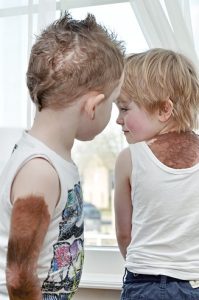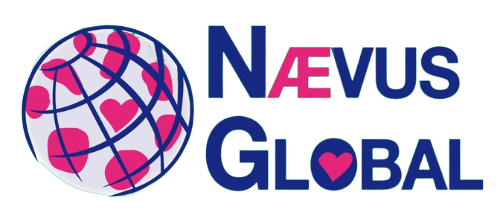Challenges
Diagnosis Congenital Melanocytic Naevus

Challenges
Having a (particularly larger) CMN brings three main problems for patients and their relatives:
- Taking care of the skin
- Uncertain risk of complications (especially melanoma, or neurological complications)
- Psychosocial consequences (cosmetic consequences)
Taking care of the skin
Fragility:
Many CMN are more delicate than normal skin, especially in newborns. They can therefore tear more easily if they are knocked or scraped. However, they do not bleed any more than normal skin, and they tend to heal well with minimal scarring.
Dryness:
Some CMN are drier than the surrounding skin, need to be washed without soap, and moisturized regularly (your doctor can advise you on this). Occasionally, CMN are very itchy.
Decrease in subcutaneous fat:
This is usually only seen with larger CMN. For some reason, the presence of the CMN interferes with setting up the layer of fat that is normally present between the skin and underlying muscle and bone. This can result in the CMN appearing to be depressed below the general skin surface, the limb, buttock, or side of the face, and appearing obviously thinner than normal. The thinner area functions just as normal – for example, a thinner leg will be perfectly strong, as the thinness is only due to less fat and not less muscle.
Absence of sweat glands:
Although not systematic, the largest or bumpy forms of CMN can sometimes have fewer sweat glands within the nevus. Thus, the CMN owner can have problems with overheating on warm days or during sports activities.
Uncertain risk of complications
Melanoma
Melanoma is a cancer of melanocytes, the skin cells which produce pigment and which make up CMN. It used to be thought that melanoma was very common in people with CMN, but we now know that it is rare, occurring in around 1-2% of all people with CMN over their lifetime. However, the risk is higher in people with very large and numerous CMN, perhaps as much as 10%, and there is a peak of risk during childhood. When considering these risks, you need to bear in mind that a person without a CMN still has a risk of about 40% of developing some kind of malignant cancer at some time in his or her lifetime. Read more…
Neurological complications
Problems in the brain or spinal cord are the most common serious complication seen in children with CMN. Because the pigment cells found in the skin and (yes, normally in) the meninges develop from the same cells as the brain in the early embryo, people with CMN can also have differences in their brain or spinal cord. Approximately one in fifteen to twenty people with large and giant forms of CMN have excess pigment cells in the brain or spinal cord. This can lead to a complication known as neurocutaneous melanocytosis (NCM). Earlier studies often used the term “melanosis” – the first means more pigment cells, and the second means more pigment. The difference is not easy to determine non-invasively.
Other rarer problems include benign brain or spinal tumors or cysts, too much fluid in the brain (hydrocephalus), or abnormal brain structure. All of these neurological problems are more common with larger and more numerous CMNs, but there is no connection with the site of the CMN. In other words, having a CMN overlying the brain or spine does not increase the chance of having neurological problems. Read more…
Psychosocial consequences
Psychological challenges
People with CMN sometimes attract looks, stares, whispering, and finger-pointing.
Children who grow up with a prominent CMN or many CMN may well have problems adjusting to the disfigurement that they perceive, particularly during the teenage years. This, however, is a very individual thing and varies depending on the child’s personality and on the support from family and friends. The problems may manifest as anxiety, depression, or lowered self-esteem.
Family members sometimes hope that a nevus will ‘fade’ and the other potential medical challenges will also disappear. Some large CMN can lighten over time, but the birthmark itself, and potential challenges, remain. This reality requires not only the person with the CMN but also their loved ones, to take some time to adapt.
It would be ideal if we were able to offer all people at risk some degree of automatic counseling during their childhood, and accompaniment to support their families as well. Some major hospitals (Great Ormond Street, London U.K.; Hôpital Necker – Enfants Malades, Paris, France; University Children’s Hospital, Zürich, Switzerland) currently have a psychology service available for their CMN patients. However, not all families want psychological input, and many hospitals and most private settings do not have this facility.
